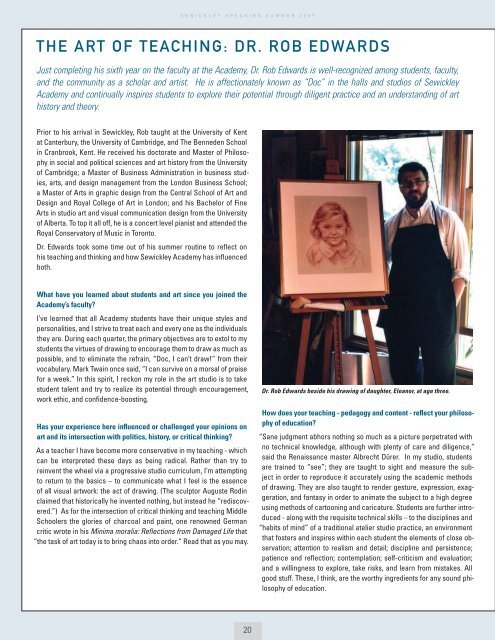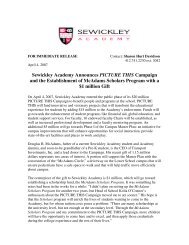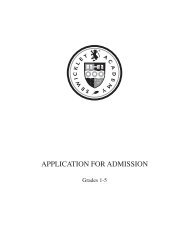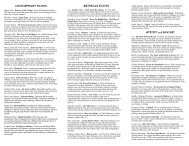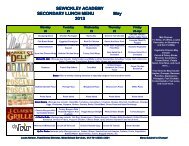Summer 2009 - Sewickley Academy
Summer 2009 - Sewickley Academy
Summer 2009 - Sewickley Academy
You also want an ePaper? Increase the reach of your titles
YUMPU automatically turns print PDFs into web optimized ePapers that Google loves.
Prior to his arrival in <strong>Sewickley</strong>, Rob taught at the University of Kent<br />
at Canterbury, the University of Cambridge, and The Benneden School<br />
in Cranbrook, Kent. He received his doctorate and Master of Philosophy<br />
in social and political sciences and art history from the University<br />
of Cambridge; a Master of Business Administration in business studies,<br />
arts, and design management from the London Business School;<br />
a Master of Arts in graphic design from the Central School of Art and<br />
Design and Royal College of Art in London; and his Bachelor of Fine<br />
Arts in studio art and visual communication design from the University<br />
of Alberta. To top it all off, he is a concert level pianist and attended the<br />
Royal Conservatory of Music in Toronto.<br />
Dr. Edwards took some time out of his summer routine to reflect on<br />
his teaching and thinking and how <strong>Sewickley</strong> <strong>Academy</strong> has influenced<br />
both.<br />
What have you learned about students and art since you joined the<br />
<strong>Academy</strong>’s faculty?<br />
I’ve learned that all <strong>Academy</strong> students have their unique styles and<br />
personalities, and I strive to treat each and every one as the individuals<br />
they are. During each quarter, the primary objectives are to extol to my<br />
students the virtues of drawing to encourage them to draw as much as<br />
possible, and to eliminate the refrain, “Doc, I can’t draw!” from their<br />
vocabulary. Mark Twain once said, “I can survive on a morsal of praise<br />
for a week.” In this spirit, I reckon my role in the art studio is to take<br />
student talent and try to realize its potential through encouragement,<br />
work ethic, and confidence-boosting.<br />
Has your experience here influenced or challenged your opinions on<br />
art and its intersection with politics, history, or critical thinking?<br />
As a teacher I have become more conservative in my teaching - which<br />
can be interpreted these days as being radical. Rather than try to<br />
reinvent the wheel via a progressive studio curriculum, I’m attempting<br />
to return to the basics – to communicate what I feel is the essence<br />
of all visual artwork: the act of drawing. (The sculptor Auguste Rodin<br />
claimed that historically he invented nothing, but instead he “rediscovered.”)<br />
As for the intersection of critical thinking and teaching Middle<br />
Schoolers the glories of charcoal and paint, one renowned German<br />
critic wrote in his Minima moralia: Reflections from Damaged Life that<br />
“the task of art today is to bring chaos into order.” Read that as you may.<br />
S E W I C K L E Y S P E A K I N G S U M M E R 2 0 0 9 S E W I C K L E Y S P E A K I N G S U M M E R 2 0 0 9<br />
THE ART OF TEACHING: DR. ROB EDWARDS<br />
Just completing his sixth year on the faculty at the <strong>Academy</strong>, Dr. Rob Edwards is well-recognized among students, faculty,<br />
and the community as a scholar and artist. He is affectionately known as “Doc” in the halls and studios of <strong>Sewickley</strong><br />
<strong>Academy</strong> and continually inspires students to explore their potential through diligent practice and an understanding of art<br />
history and theory.<br />
20<br />
Dr. Rob Edwards beside his drawing of daughter, Eleanor, at age three.<br />
How does your teaching - pedagogy and content - reflect your philosophy<br />
of education?<br />
“Sane judgment abhors nothing so much as a picture perpetrated with<br />
no technical knowledge, although with plenty of care and diligence,”<br />
said the Renaissance master Albrecht Dürer. In my studio, students<br />
are trained to “see”; they are taught to sight and measure the subject<br />
in order to reproduce it accurately using the academic methods<br />
of drawing. They are also taught to render gesture, expression, exaggeration,<br />
and fantasy in order to animate the subject to a high degree<br />
using methods of cartooning and caricature. Students are further introduced<br />
- along with the requisite technical skills – to the disciplines and<br />
“habits of mind” of a traditional atelier studio practice, an environment<br />
that fosters and inspires within each student the elements of close observation;<br />
attention to realism and detail; discipline and persistence;<br />
patience and reflection; contemplation; self-criticism and evaluation;<br />
and a willingness to explore, take risks, and learn from mistakes. All<br />
good stuff. These, I think, are the worthy ingredients for any sound philosophy<br />
of education.<br />
What do you do outside of teaching at <strong>Sewickley</strong> <strong>Academy</strong>?<br />
I am a practicing professional artist outside the <strong>Academy</strong>. I<br />
work on many private commissions - personal, family, corporate<br />
- both in the area and out-of-state. For a decade, I have<br />
somehow managed a consortium of over 40 international artists<br />
via an agency called Drawn & Quartered, which serves a<br />
varied constituency of newspapers and magazines worldwide.<br />
What other little free time I have is spent with my own family of<br />
budding young artists, and digging gardens for my wife.<br />
Please share stories from some of your most memorable<br />
projects.<br />
Some years ago I was commissioned by the University of Kent<br />
in the UK to paint Michel Rôcard, former Prime Minister of<br />
France and European Union Commissioner, who was invited<br />
to Canterbury to give a syntillating keynote address on economics<br />
and the benefits of the euro. I portrayed the illustrious<br />
man as a latter-day Napoleon, standing with hand in jacket,<br />
surrounded by the accoutrements of worldly statecraft. The<br />
Corsican general has a mixed reputation with French socialists,<br />
and here my sensibilities as a political caricaturist collided<br />
with what traditionally could have been formalist flattery.<br />
The portrait was presented to Rôcard onstage with great fanfare.<br />
The ensuing reception was mixed: the University’s Politics<br />
Department (loyal British subjects all) absolutely loved it,<br />
but Madame R never did invite me to Paris for dinner.<br />
They say you should never underestimate the power of art. I<br />
also had an opportunity to draw an oversized portrait of one<br />
Mike Tyson, former undisputed heavyweight champion of the<br />
world, “baddest man on the planet,” and now a latter-day<br />
movie star. This particular work was published and circulated<br />
in many syndicated newspapers at the time, and soon after<br />
Tyson’s entourage came around to my apartment to relieve<br />
me of the original. I sensed life imitating art with Drawn &<br />
Quartered here, but fortunately for me, Iron Mike took a real<br />
shining to the drawing, and the exchange was cordial. In his<br />
very next fight, Tyson lost the belt to James Buster Douglas.<br />
How are you involved in the community?<br />
I try to spend time with <strong>Sewickley</strong>’s arts and crafts community,<br />
in particular collaborating with my good friend Mark Rengers<br />
of <strong>Sewickley</strong> Gallery and Frame Shop regarding student exhibitions<br />
and framing issues. My son is also an avid member of<br />
the <strong>Sewickley</strong> Cycling Club, so if you see a laboring “Clydesdale”<br />
[sic] on a bike badly trailing a youthful Lance Armstrong<br />
through town - that will be father and son.<br />
UP-AND-COMING<br />
CROSSING BOUNDARIES<br />
What were you doing the summer of your 15th year? Was it your<br />
first year as a camp counselor? Were you bussing tables at a<br />
local restaurant? Or, spending your days poolside? This summer,<br />
<strong>Sewickley</strong> <strong>Academy</strong> student Evan Fuhrer ‘12 will be performing original<br />
music across the region with his local band Crossing Boundaries. Not<br />
bad for a 15-year-old with a passion for music inspired by the Beatles.<br />
Evan and former SA student Jacob Klein are the two singers and<br />
songwriters for the band, which has established itself as one of the<br />
region’s premier rock ‘n’ roll performers. They have been featured in<br />
the Pittsburgh-Post Gazette and have appeared on KDKA’s Pittsburgh<br />
Today Live. One of their songs, Pretty Lady Goodbye, is being played<br />
on WYEP radio station – the youngest band debut in the station’s<br />
history. They recently opened for Michael Glabiki of Rusted Root and<br />
have attracted over 300 people to their shows. They also just performed<br />
at The Pittsburgh Music Festival as one of the area’s best up-and-<br />
coming bands. Sounds like they are on their way.<br />
So, how did it all begin? Evan began taking piano lessons and Jacob<br />
started playing the guitar. It was not until Evan discovered music<br />
that he loved and Jacob started singing that it all clicked. It helps to<br />
have a community that supports them, explain the musicians. From<br />
parents, to friends, and teachers, Crossing Boundaries has a strong<br />
following in the region and at school.<br />
Over the years, Evan and Jacob have been influenced and inspired by<br />
the Beatles, travel, and nature. As for the future – Jacob has his sights<br />
set on a Grammy. Evan, on the other hand, is taking it all in stride, “My<br />
goal is to write music that I like and is fun to play. I am taking it year by<br />
year and seeing how far it goes.”<br />
Jacob and Evan have “the unique ability to write beautifully constructed<br />
pop songs that appeal to people of all ages. Their soaring harmonies<br />
and wonderful lyrics remind many of The Beatles,” explains one critic.<br />
Their first CD is titled Here’s To Yesterday, a reference to the wonderful<br />
music of the ‘60s, and has received wonderful reviews from as far<br />
away as London. Even at 15, you can go a long way with talent, passion,<br />
and a supportive community.<br />
21


